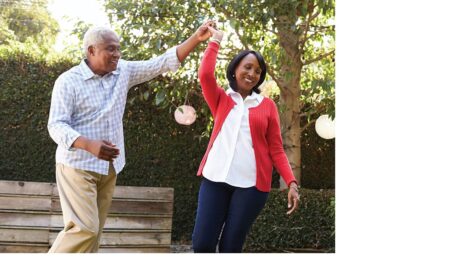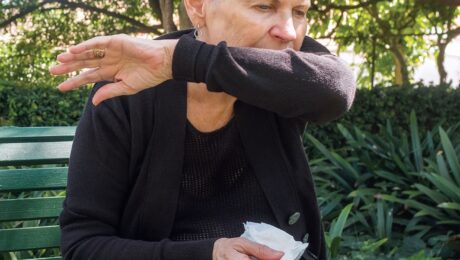NEW YEAR’S GOALS
ACTIVITIES
For older adults, making a New Year’s resolution can be a symbol of hope. [cite: 1, 2] Resolutions are a sign to their inner selves that they believe they will be around for the coming year to enact those changes. [cite: 2] The word “resolution” has gotten a stigma as something that people start on January 1st and break on January 2nd. [cite: 3] Calling a resolution a goal might help everyone get out of the mindset that these are things you say only New Year’s Day. [cite: 4, 5] Goals can be set any time. [cite: 5] You can help your loved one create some measurable goals for the coming year. [cite: 5, 6] In fact, helping them reach their goals might be a goal for yourself!
Make goals bite-sized and measurable. [cite: 7] For example, instead of saying “lose weight,” set smaller monthly goals to eliminate one poor eating choice from your diet or add one extra daily activity. [cite: 7, 8] Losing weight will be a product of those goals, but not the goal itself. [cite: 8]
Goals don’t have to be boring! [cite: 9] Especially as we age, there are legacies to be passed down. [cite: 9, 10] Consider asking your family members to sit down with you (even virtually) each week to pass down recipes, stories, and lessons they’ve learned throughout their lives. [cite: 10, 11] This can be a great family activity that feels less like a resolution and more like the right thing to do. [cite: 11, 12]
Source: Philips Lifeline and American Psychological Association
Personal Goals
- Cleaning and Sorting – As we move through life, it’s easy to amass items that just don’t serve us anymore. [cite: 13] As organizational expert Marie Kondo says, keep only those things that spark joy. [cite: 13] Our homes should be a haven. [cite: 13, 14] That old vase you picked up in a thrift store on a whim, which is out only to be dusted, can probably go to someone who might value it more. [cite: 14, 15]
- Technology – Video chats with family members can ease loneliness and allow us to keep an eye on them. [cite: 15, 16] Add a form of digital music, which has been proven to help with mental acuity and emotional happiness. [cite: 16, 17] Teaching your loved one how to email or text will allow them to connect with their peers more easily. [cite: 17, 18]
Source: Philips Lifeline
Inspiration
Hubert Jones was 69 when he founded the Boston Children’s Chorus, which includes young people of different ages, races, ethnicities and socioeconomic backgrounds. [cite: 19] Its mission combines artistic excellence and an agenda for social change. [cite: 19]
Source: US News and World Report
NEW YEAR’S GOALS
ACTIVITIES
Health Goals
- Exercise – Increasing exercise can be as simple as getting your loved one a pedometer and a goal for a certain number of steps each day. [cite: 20, 21] You can make it a competition, if that is something they’d enjoy, or a reward system where they earn something for achieving the daily goal. [cite: 21, 22]
- Medications – As we age, there are an increasing number of medications to keep track of. [cite: 22, 23] A worthwhile goal is to take an annual look at the medications in your loved one’s home. [cite: 23, 24] Check to see that none are expired and there aren’t duplicates or varied dosages. [cite: 24, 25]
- Vaccinations – If vaccinations are not on the annual schedule, it’s a good time to make sure that your loved one is up to date on the ones their doctor might recommend, such as flu, pneumonia, and shingles. [cite: 25, 26]
Source: Medical Alert Advice
Financial Goals
- Legal Documents – While it seems like setting up a will or trust or other legal decisions might be a “one and done,” it is useful to review these documents annually. [cite: 26, 27] The people designated in these documents may no longer be in our lives or in a position to take on any responsibilities mentioned. [cite: 27, 28]
- Bills – A great goal for a new year is to consolidate debt and to set up a plan for paying bills more efficiently. [cite: 28, 29] Scattered accounts can lead to financial mistakes and even fraud. If your loved one isn’t using autopay or bill pay systems, you can work with them to learn how to manage finances online. [cite: 29, 30] If they are uncomfortable with the prospect of taking their account management online, a first step can be to set up smaller accounts, like utilities, to get them used to the process. [cite: 30, 31]
Source: US News and World Report
Inspiration
Nola Ochs became the oldest college graduate at 95 and lived to 105. [cite: 31, 32] After graduation, Princess Cruises hired Ochs as a guest lecturer on a nine-day Caribbean cruise. [cite: 32] Ernestine Shepherd is an American bodybuilder best known for being, at one point, the oldest competitive female bodybuilder in the world. [cite: 32, 33] She will be 84 this year and is still an active bodybuilder. [cite: 33, 34]
Source: US News and World Report
Gratitude’s Impact on Your Well-being
Gratitude is a thankful appreciation for what an individual receives, whether tangible or intangible. In the process, people usually recognize that the source of that goodness lies at least partially outside themselves. As a result, gratitude also helps people connect to something larger than themselves as individuals – whether other people, nature, or a higher power. Gratitude has the power to heal and to improve physical health. It can make people happier, improve relationships, lessen depression, and even decrease pain.
In several recent studies, organizations have proven a link between health and a gratitude practice, especially in older adults. People of all ages and nationalities who practice gratitude report fewer health complaints (including headaches, gastrointestinal issues, blood pressure, respiratory infections, sleep disturbances, and colds) than their less grateful counterparts. One study found that a regular gratitude practice decreased the production of cortisol, which in turn lowered blood pressure. The participants had an average heart rate significantly lower than the group that didn’t practice gratitude. Helping seniors establish regular gratitude patterns might diminish feelings of stress about aging and replace them with a more relaxed and content demeanor.
Source: Harvard Medical School and Greater Good Science Center UC Berkeley
“Gratitude is the healthiest of all human emotions. The more you express gratitude for what you have, the more likely you will have even more to express gratitude for.”
– Zig Ziglar
“Make choices that bring love and joy to your body. It’s not about perfection; it’s about love and gratitude for an amazing body that works hard and deserves your respect.”
– Alysia Reiner
“It is impossible to feel grateful and depressed in the same moment.”
– Naomi Williams
Easy Ways To Incorporate Gratitude Into Our Daily Lives
- Keep a Gratitude Journal – Write down 3-5 things each day that are blessings to you. By keeping a journal, you can easily see the positives in your days and ensure those good things continue to happen. If you’re helping a parent or loved one who finds writing difficult, consider encouraging them to record a short video each day about what they are grateful for. You can watch them together, which will remind them of their positives, as well as spark conversation.
- Write a Thank You Note – This practice helps both the giver and the receiver. Occasionally write one to yourself. As a caretaker, you deserve gratitude. Perhaps your loved one is not able to thank you themselves, but that does not mean that the intention isn’t there and that you can’t thank yourself on their behalf.
- Thank Someone Mentally – Often just thinking in a grateful way about someone can soften a relationship and bring healing to your own thoughts.
- Pray – While prayer may not be for everyone, it is a specific way for believers to express their gratitude to a higher power. Praying with your loved one can be a profound connection.
- Use Gratitude Cues – Keep photos out that remind you and your loved one of things that make them happy. Gratitude quotes are also good for reminding everyone to stay positive.
Gratitude Action Items
- Think of one thing or person you’re grateful for when you wake up in the morning. Share that feeling with someone else.
- Take a few minutes each day to mindfully close your eyes, breathe in and out slowly, and focus your mind on positive thoughts.
- Make a Gratitude Jar – As people come up with something to feel grateful for, they write it down and put the paper in the jar (with or without their name). During family meals or together time, pull notes from the jar to read aloud. This is a beneficial activity if your older family members suffer from dementia as they might not be able to participate in writing the grateful notes, but can benefit from hearing them read aloud.
- On medical visit days, find one thing you are grateful for in the experience. It can be as simple as appreciating the smile from the receptionist.
In any of these ideas for expressing gratitude, the goal is to make it a regular part of every day something that comes naturally, even when times are hard. It’s a habit that can switch the brain from saying “everything is horrible” to “I’m grateful for this specific thing in my life when other things are going wrong.”
Source: Harvard Medical School and Mayo Clinic





